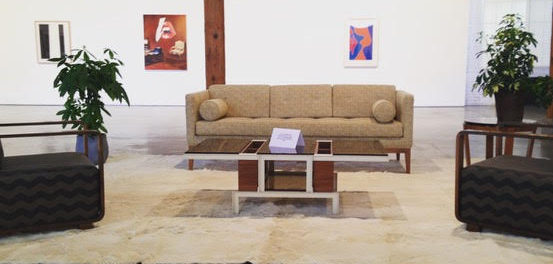Modern: North American tastes of the past through Brian Rideout
Entering Parisian Laundry’s latest exhibition Modern, one is propelled back in time into an open-spaced living room from the mid-twentieth-century. Resting on a beige fur carpet, a khaki-brown cushioned couch sits at the center of the gallery facing a glass coffee table. Two household plants sit side-by-side of the couch while two chairs with wave-like patterns and dark wooden arm rests face the couch diagonally in opposite directions. Surrounding this mise-en-scene are abstract paintings composed of vivid colors, and, reflexively, paintings of interior spaces one can find in an upper-middle class home created by the artist in question, Brian Rideout (b. 1986).
In Modern, Parisian Laundry focuses on the content of the Toronto-based artist’s series, American Collection Paintings, specifically the display of mid-twentieth century North American upper-class tastes found in art and interior designs, which is accentuated through the inclusion of mid-twentieth century furniture and the abstract artworks of bright colors and hard edges by the modernist painters: Al Held (American, 1928 – 2005), Fernand Leduc (Canadian, 1926 – 2014) and Guido Molinary (Canadian, 1933 – 2004). Curatorially, Rideout’s artworks are hung side-by-side with the abstract works based on the similarities of color and composition.

Brian Rideout. Modern. Parisian Laundry. Photo by Stephanie Gangé
American Collection Paintings, in part, alludes to the famed mid-twentieth century artists as he paints an artwork from Joself Albers, Tom Wesselmann, Vasa Mihich, Donald Judd and Mark Rothko within each painting; it appears as though the aesthetics of the artworks determine the design of the interior. In terms of style, the works are realistically painted with a single coat of oil paint, evoking a photo found in a glossy magazine. In fact, Rideout explains that he uses old interior design books as his source material; effectively he paints existing photographs, including its inaccuracies of color from the printing process. For example, American Collection Painting 15 (Rothko) (2017) is a vertically composed portrayal of a white-walled living room from a downwards perspective. One of Rothko’s large vertical “red” paintings hangs against the wall acting as a focal point of the room in which the rest of the elements follows its design. For instance, blood-red couches sit across from each other on an abstract-designed carpet in front of a fireplace while green plants not only act a complimentary color to the red none but frames the room and the painting. Although this is clearly a space for one to occupy, there is a sanitized appearance, as if simply for display and untouched by human hands enforcing the fact that it is a depiction from a design book. Nevertheless, this room is an example of a fashionable interior showcasing cultural taste through art.
Next to American Collection Painting 15 (Rothko) is Fernand Leduc’s, S.G. 4 (1970). An abstract screen print composed of three colors, the large blots of yellow and orange swirl together while a touch of purple frames the left side of the print and the bottom right. Although not completely relating to Brideout’s painting in terms of style, Leduc’s design bears similarity to the abstract designs found within the carpet in American Collection Painting 15.

Brian Rideout. Modern. Parisian Laundry. Photo by Stephanie Gangé
Although the gallery situates his works with modernist painters, Rideout is far from being a modernist. Modernist painting is specific to mid-twentieth century abstraction, which rejected representation and placed emphasis on the limitations of painting; color, lines and shapes. Contrastingly, Rideout performs the opposite. The artist pictorially references a cultural and historical blend of art history, interior design, tastes and consumerism as Parisian Laundry contextualizes the works within modernist abstraction. Needless to say, I would highly recommend this exhibition, especially twentieth-century enthusiasts.
Modern is at the Parisian Laundry from July 14 to August 12. Find more information on Modern here.





